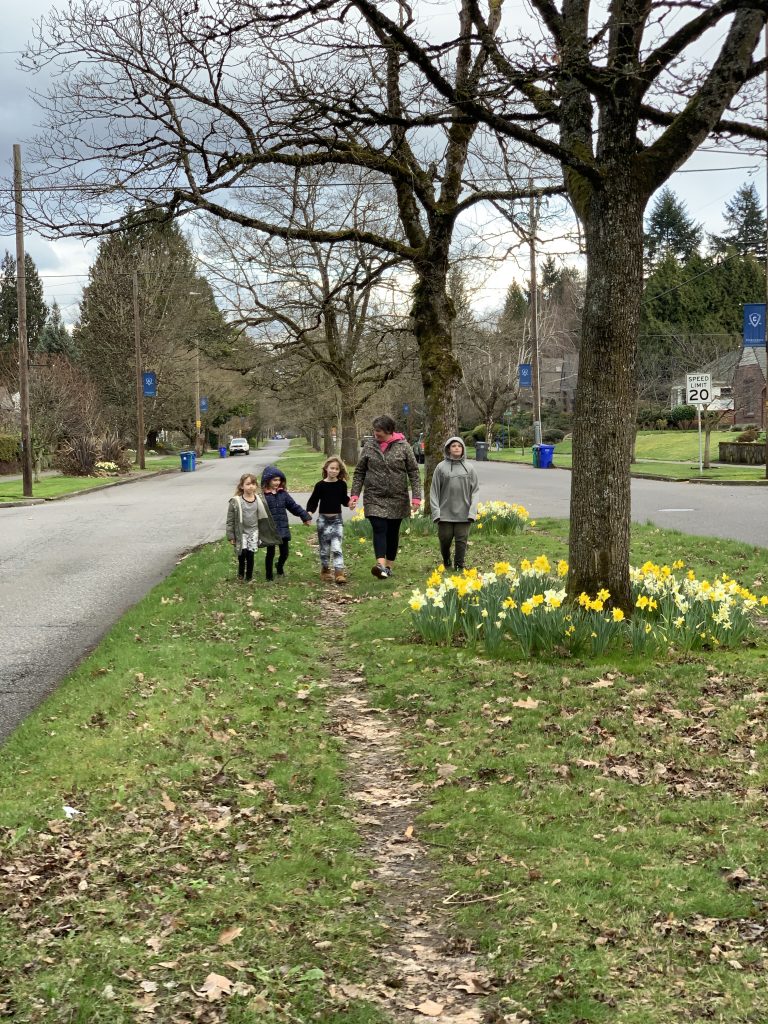Explore linear arboretum April 16

By Jim Gersbach | Linear Arboretum Founder | Concordia Tree Team Member
Local residents interested in trees are invited to join me on a free walk to explore the Concordia Linear Arboretum Saturday, April 16. The 90-minute walk, sponsored by Portland Parks & Recreation Urban Forestry, will start at 9 a.m. at the southeast corner of 30th Avenue and Ainsworth Street.
There are only a handful of tree-lined medians in the city. Concordia is fortunate to have one of them – a stretch of about 1.5 miles running from Fernhill Park to Martin Luther King Jr. Boulevard.
Since 2005, the median – and the right-of-way planting strips on the north and south sides of the street – have been designated by the city as an investigational arboretum. This has permitted the planting of promising new species of trees in an actual street setting.
Here, city residents can get to know less familiar approved street trees. Including ones in a trial for suitability in this climate.
Years ago the city created a street tree arboretum in Delta Park, but it is hard to find, not well served by public transit and is in a park, not an actual street setting.
Ainsworth has many advantages over Delta Park. It is flat, has wheelchair-accessible sidewalks, is served by public transit and is easy to navigate using the house numbers and numbered streets.
Originally conceived as a grand entrance to the city from the east, Ainsworth was envisioned as a boulevard with a tree-lined median running from the Columbia Gorge to the Willamette River.
The only part that was ever developed as such was what exists today. The original Ainsworth planting was a classic monoculture – a single species of tree (Acer platanoides) that conformed to the uniform look so prized by European city planners.
As nice as this may have looked when the trees were in their prime, Ainsworth was a maple desert. After the maple trees bloomed, there was no more nectar for pollinators the rest of the year.
A single tree species also couldn’t offer the variety of nuts or fruits that a diverse planting would, so it was less useful to wildlife. Even more concerning, it made Ainsworth more vulnerable to any pest or disease that especially afflicted maples.
- Earlier attempts to diversify the median relied on just three species:
- Raywood ash that were lovely but tended to fall over in storms
- Thin-barked European beech, of which 80 percent died from drought or sunscald
- Northern red oaks, which did well but were only one type of oak among scores suitable for Portland’s climate
The limited new plantings still reflected that about 90 percent of the street trees are from just 10 genera – overwhelmingly maples and short-lived trees like flowering plums, pears and crabapples.
Yet Portland’s mild climate can support hundreds of different tree species. As the city began to allow and then encourage more choices of species, many people still selected only what was familiar. Exposing people to great new options is what the Linear Arboretum is all about.
When trees die, we replace them with diverse species and new cultivars with better forms or disease resistance.
Over 16 years, diversity in the median has grown sixfold, from only four genera to 28. The number of species has increased from just six to 47. There were no evergreen species, conifers or native trees. Now there are trees native to Oregon, a half dozen broadleaf evergreens and 10 conifer species .
Many people and organizations have helped with this project. Nurseries and the nonprofit Friends of Trees as well as Portland Parks & Recreation Urban Forestry staff provided trees and mulch. The parks folks have also removed dead trees, ground the stumps to enable new plantings and watered young trees for two summers. Members of the city Youth Conservation Crew have weeded and mulched.
Because Portland has experienced multiple drought years, I have also hand-watered a lot of the trees beyond two years to help them establish well.
This spring, with the help of neighborhood volunteers – shout out to Rebecca O’Neil of the Concordia Tree Team – we’re launching an online website documenting all the trees with photos and descriptions to allow self-guided tours to fulfill the educational mission of the Ainsworth Linear Arboretum.
Visit that new website at AinsworthLinearArboretum.org.
Concordian Jim Gersbach is public affairs specialist for the Oregon Department of Forestry and former urban forestry specialist for the city of Portland. His volunteer activities include serving on the Concordia Tree Team, founding the Ainsworth Linear Arboretum, acting as an outreach guide for the Hoyt Arboretum, and providing education as well as leading planting and pruning crews for Friends of Trees.